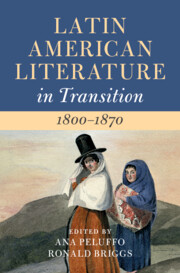Book contents
- Latin American Literature in Transition 1800–1870
- Latin American Literature in Transition
- Latin American Literature in Transition 1800–1870
- Copyright page
- Contents
- Figures
- Contributors
- Acknowledgments
- Introduction
- Part I Aesthetics of Disorder
- Chapter 1 The Paraguayan War Imagined
- Chapter 2 Networks of New World Authority
- Chapter 3 Artisans and Affective Labor
- Chapter 4 Reading (in) the Streets
- Chapter 5 Publicity and Print Culture
- Chapter 6 Literature and Political Corruption
- Chapter 7 Emotions and Politics in the Era of Caudillos
- Part II Affective Communities
- Part III Intersectional Subjectivities
- Part IV Transoceanic Consciousness
- Index
- References
Chapter 3 - Artisans and Affective Labor
from Part I - Aesthetics of Disorder
Published online by Cambridge University Press: 24 January 2023
- Latin American Literature in Transition 1800–1870
- Latin American Literature in Transition
- Latin American Literature in Transition 1800–1870
- Copyright page
- Contents
- Figures
- Contributors
- Acknowledgments
- Introduction
- Part I Aesthetics of Disorder
- Chapter 1 The Paraguayan War Imagined
- Chapter 2 Networks of New World Authority
- Chapter 3 Artisans and Affective Labor
- Chapter 4 Reading (in) the Streets
- Chapter 5 Publicity and Print Culture
- Chapter 6 Literature and Political Corruption
- Chapter 7 Emotions and Politics in the Era of Caudillos
- Part II Affective Communities
- Part III Intersectional Subjectivities
- Part IV Transoceanic Consciousness
- Index
- References
Summary
The export of guano fueled a period of accelerated, uneven modernization in nineteenth-century Perú. Beginning in the 1840s, deposits of seabird excrement on islands off the coast were exploited to provide an effective fertilizer for agricultural production in the industrializing north Atlantic. For the next three decades, state coffers and the fortunes of those controlling the trade swelled.
- Type
- Chapter
- Information
- Latin American Literature in Transition 1800–1870 , pp. 53 - 67Publisher: Cambridge University PressPrint publication year: 2022



